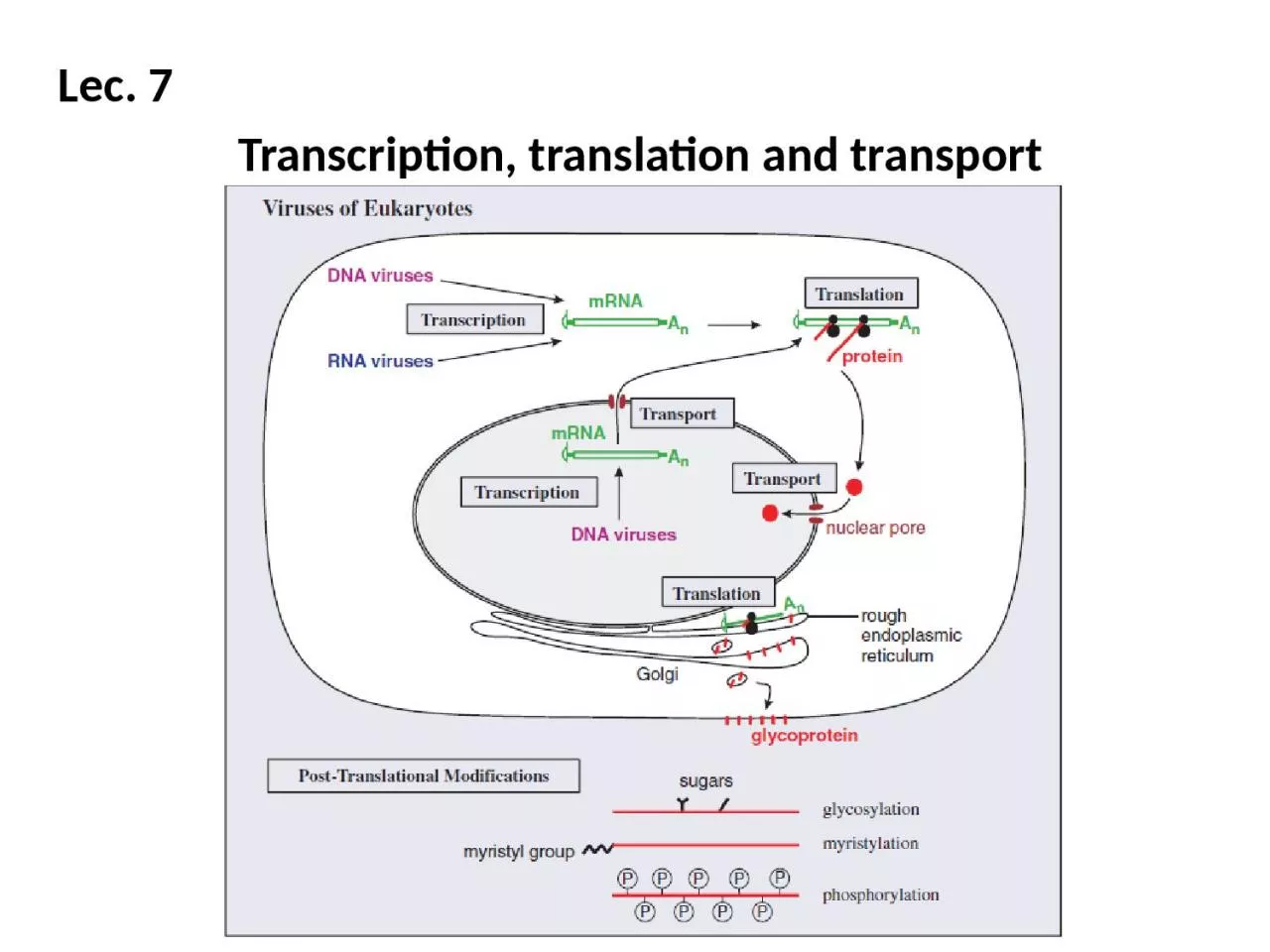

Transcription translation and transport Transcription of virus genome In the summary of the scheme depicted below most of the nucleic acid strands are labelled or This labelling ID: 935798
Download Presentation The PPT/PDF document "Lec . 7" is the property of its rightful owner. Permission is granted to download and print the materials on this web site for personal, non-commercial use only, and to display it on your personal computer provided you do not modify the materials and that you retain all copyright notices contained in the materials. By downloading content from our website, you accept the terms of this agreement.
Slide1
Lec. 7 Transcription, translation and transport
Slide2Transcription of virus genomeIn the summary of the scheme depicted
below, most
of the nucleic acid strands are labelled (+) or (−). This labelling is relative to the virus mRNA, which is always designated (+). A nucleic acid strand that has the same sequence as mRNA is labelled (+) and a nucleic acid strand that has the sequence complementary to the mRNA is labelled (−). The viruses with (+) RNA genomes (Classes IV and VI) have the same sequence as the virus mRNA. When these viruses infect cells, however, only the Class IV genomes can function as mRNA.
Slide3Slide4These viruses are commonly referred to as plus-strand (or positive-strand) RNA viruses. The Class V viruses
are commonly
referred to as minus-strand (or negative-strand) RNA viruses.Class VI viruses must first reverse transcribe their ssRNA genomes to dsDNA before mRNA can be transcribed. Because they carry out transcription in reverse (RNA to DNA) Class VI viruses are known as retroviruses. The ability of some DNA viruses to carry out reverse transcription was discovered later; these viruses became known as pararetroviruses and Class VII was formed to accommodate
them.
There are a few single-stranded nucleic acids
of viruses
where there is a mixture of (+) and (−)
polarity within
the strand, in other words there are open
reading frames
(ORFs) in both directions. Genomes of this
type are
known as
ambisense
, a word derived from the
Latin
ambi
, meaning ‘on both sides’ (as in ambidextrous
). Examples
of
ambisense
genomes include the
ssDNA
genomes
of the
geminiviruses
, which are plant
viruses, and
the
ssRNA
genomes of the
arenaviruses
,
which are
animal viruses and include the causative agent
of Lassa
fever.
Slide5Modifications to the central dogma
Slide6How is transcription controlled in eukaryotes?The expression of a gene is controlled
by various sequences in the
DNA:• enhancers – sequences that contain binding sites for transcription factors, which affect the rate of transcription;• a promoter – the ‘on’ switch;• a terminator – the sequence that causes the enzyme to stop transcription.Transcription factorsTranscription factors are proteins that bind specifically to promoter and enhancer sequences to control gene expression. Some viruses produce their own transcription factors, such as herpes simplex virus VP16, which is a component of the virion.
Some cell transcription factors can activate
or repress
transcription of viral genes.
Tissue-specific transcription
factors are required by some
viruses, which
probably explains why some viruses are
tissue specific
.
Slide7Slide8TranscriptasesTranscriptase is a general term for an enzyme
that carries
out transcription. Viruses that replicate in the nucleus generally use a cell enzyme, while viruses that replicate in the cytoplasm encode their own.A DNA virus needs a DNA-dependent RNA polymerase to transcribe its genes into mRNA. Viruses that carry out transcription in the nucleus generally use the cell RNA polymerase II; these include the retroviruses, as well as many DNA viruses. DNA viruses that replicate in the cytoplasm use a virus-encoded enzyme because there is no appropriate cell enzyme in the cytoplasm.An RNA virus (apart from the retroviruses) needs an RNA-dependent RNA polymerase to transcribe
its
genes into mRNA. Each virus in Classes III, IV
and V
encodes its own enzyme, in spite of the fact
that the
cells of plants and some other eukaryotes
encode
ssRNA
-dependent
RNA polymerases
.
The retroviruses and the
pararetroviruses
perform reverse transcription using enzymes known
as reverse
transcriptases
. These
enzymes are
RNA-dependent DNA polymerases, but
they also
have DNA-dependent DNA polymerase
activity, as
the process of reverse transcription
involves synthesis
of DNA using both RNA and DNA as
the template
.
Slide9Slide10Capping transcripts (mRNA)The cap is a guanosine
triphosphate
joined to the end nucleotide by a 5’–5’ linkage, rather than the normal 5’–3’ linkage. A methyl group is added to the guanosine. The cell enzymes that carry out the capping activities are guanylyl transferases (they add the guanosine 5-triphosphate) and methyl transferases (they add the methyl groups). These enzymes are located in the nucleus and most of the viruses that carry out transcription in the nucleus, like the
retroviruses, use
the cell enzymes
.
Many of the viruses that
replicate in
the cytoplasm, however, encode their own
capping and
methylating
enzymes; these viruses include
the poxviruses
, the
reoviruses
and the coronaviruses
.
Not all mRNAs are capped.
Picornaviruses
,
for example
, do not cap their
mRNAs.
Polyadenylation
of transcripts
A series of adenosine residues (a
polyadenylate
tail; poly(A
) tail) is added to the
3’
end of most
primary transcripts
of eukaryotes and their viruses
. For instance, HIV-1, simian virus 40,
picornaviruses
and
rhabdoviruses
have
polyadenylated
genomes.
Slide11Translation in eukaryotes
A
typical eukaryotic mRNA is monocistronic, i.e. it has one ORF from which one protein is translated (Figure 6.7). Sequences upstream and downstream of the ORF are not translated. Some large ORFs encode polyproteins, large proteins that are cleaved to form two or more functional proteins.
Slide12Transport in eukaryotic cellsVirus molecules synthesized in the infected cell must also
be transported to particular sites. Virus
mRNAs are transported from the nucleus to the cytoplasm, and virus proteins may be transported to various locations, including the nucleus.